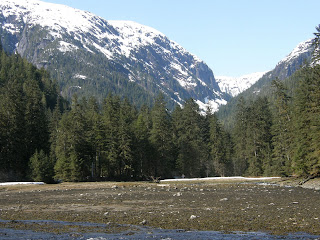
Petersburg is in the middle of the Alexander Achipelago. It is best experienced from the water but it’s origins are best observed from the air. The interconnected events of plate tectonics, volcanic activity, and glaciation are working in tandem with the weather cycle to create a water generating machine. The most prominent aspect of the landscape is the the Coast Range Mountains. The steep mountains pushed up from the collision of plates form a barrier to air currents as they move in from the west. Clouds laden with moisture from the warm Pacific currents hit the coast range and dump huge amounts of snow. The result is the Stikine Icefields and numerous advancing and retreating glaciers. Harold Stowell has written and excellent and easy follow text on local geology.
Water is the unifying theme of this area. In Petersburg, we recieve some 150 inches of precipitation a year. This Pacific rainforest biome nurtures a multitude of creeks, streams, and rivers that provide habitat to 5 species of salmon. The rain and conversely, lack of fire, allow for a jungle of coniferous forest made up primarily of spruce and hemlock and a dense undergrowth. These rich forests have some of the highest biomass per acre in the world. For more information on the biological richness of Southeast, Rita O'Clair's Nature of Southeast Alaska is by far the best guide available.
Water is the unifying theme of this area. In Petersburg, we recieve some 150 inches of precipitation a year. This Pacific rainforest biome nurtures a multitude of creeks, streams, and rivers that provide habitat to 5 species of salmon. The rain and conversely, lack of fire, allow for a jungle of coniferous forest made up primarily of spruce and hemlock and a dense undergrowth. These rich forests have some of the highest biomass per acre in the world. For more information on the biological richness of Southeast, Rita O'Clair's Nature of Southeast Alaska is by far the best guide available.
The early inhabitant of this area used the abundant resources to establish a lifestyle of relative ease, although in times of cyclical scarcity, famine was not unheard of. Tlingit clans usually travelled to prize streams in the summer to harvest fish and then spent the winters in permanent villages in plank houses made from the sturdy timbers. They designed large, high browed canoes that were especially seaworthy in the choppy waters of the Inside Passage. Plentiful wildlife and year round access to foods from the sea and tidal zones rounded out their diet.
 In the late 1800's, SE Alaska was providing the rich seafood bounty to the Seattle cannery industry. Petersburg provided an ideal spot to build a cannery not just because of good fishing but also because of its location the the LeConte Glacier, a tidewater glacier about 10 mile from town that provided an unending supply of ice to the cold storage facility. Petersburg is still a community (like most in Alaska) that is still very connected to its environment. Our primary industry is still based on the harveting of seafood. Connections to the land and water are still strong by native and non-native alike. Traditonal knowledge extends through the Norwegian, Philipino, and Tlingit cultures/communities. This year, Petersburg celebrates it’s 100th year as an incorparated city. While Scandanavians built the first permanent settlement on the tip of this island, the Petersburg Indian Association works hard to keep it’s cultural heritage alive. They provide a native studies course in the elementary school that introduces all students to the stories and traditions of their culture. Although considered part of the "landless" native groups their connection to the natural landscape that is now Petersburg, is still vibrant.
In the late 1800's, SE Alaska was providing the rich seafood bounty to the Seattle cannery industry. Petersburg provided an ideal spot to build a cannery not just because of good fishing but also because of its location the the LeConte Glacier, a tidewater glacier about 10 mile from town that provided an unending supply of ice to the cold storage facility. Petersburg is still a community (like most in Alaska) that is still very connected to its environment. Our primary industry is still based on the harveting of seafood. Connections to the land and water are still strong by native and non-native alike. Traditonal knowledge extends through the Norwegian, Philipino, and Tlingit cultures/communities. This year, Petersburg celebrates it’s 100th year as an incorparated city. While Scandanavians built the first permanent settlement on the tip of this island, the Petersburg Indian Association works hard to keep it’s cultural heritage alive. They provide a native studies course in the elementary school that introduces all students to the stories and traditions of their culture. Although considered part of the "landless" native groups their connection to the natural landscape that is now Petersburg, is still vibrant.

Great literary references, style, images and cultural connections! Rich.
ReplyDelete